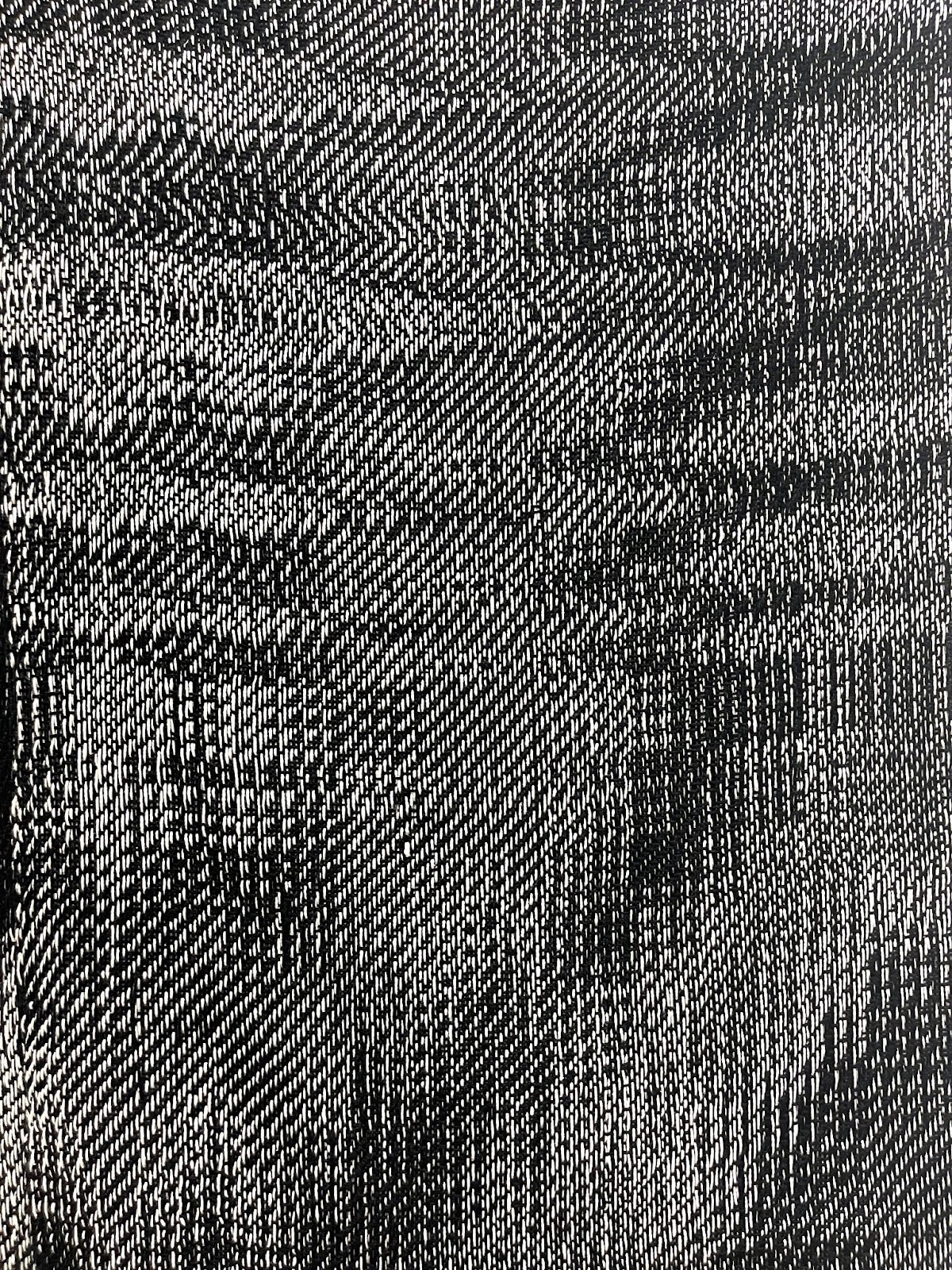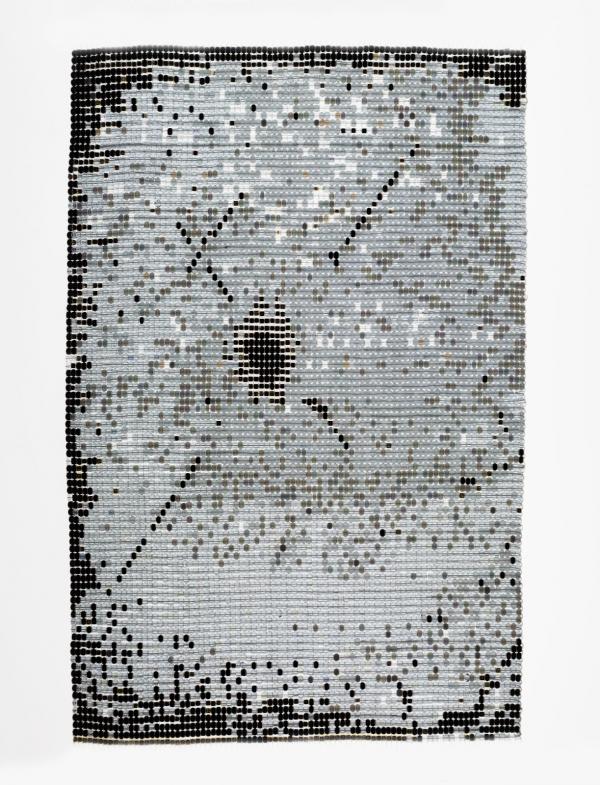Earlier this year, LACMA collaborated with Mt. Wilson Observatory for Sarah Rosalena: Standard Candle, an exhibition featuring Art + Technology Lab grant recipient Sarah Rosalena’s woven and beaded textiles. Based on images captured by the observatory’s 100-inch telescope and made using computer code, the featured artworks interrogated Western science and technology's attempt to subjugate indigenous beliefs and cosmologies. These artworks and more are currently on view in the artist’s mid-career survey at the Columbus Museum of Art, In All Directions, through February 4, 2024. The following is an excerpt of an essay by critical theorist and scholar Elizabeth Povinelli, the full version of which is featured in the exhibition catalogue. Povinelli reflects on the many ways Rosalena engages Indigenous practices and knowledge to realize artworks that turn colonial technologies on their head and “open the world to different modes of infinity.” Rosalena and Povinelli will also be in conversation at the Wexner Center for the Arts at Ohio State University on January 23, 2024.
[Sarah] Rosalena does not figure her artistic practice as an encounter between Western forms of science and technology—for example, Western modes of space exploration and of intelligence gathering and deployment—and Indigenous forms of relational knowledge. To frame her works as an encounter would, after all, reinforce the idea of Western technoscience as a sui generis field—something exterior to ongoing colonialism, something that encounters other knowledge forms as it rampages across the earth. Rosalena’s works instead insist that her Wixárika relatives, as well as the relatives of other Indigenous peoples, are already inside Western sciences and technologies. These relatives are embedded in its circuitry, its location, and its aims to conquer nature through a totalizing and divisive knowledge of it. When I sit with Rosalena’s work, when I talk with her, and when I read the interviews she has conducted, I recall Zoe Todd’s struggle to understand how she can reawaken a caring relation with her Métis ancestors—namely those whom the petrol industrial complex has turned into petrochemicals—who have been transformed and absorbed into the toxic machinery of extractive consumptive capitalism, sunk in its carbon imaginary.¹ When Rosalena circuits Indigenous patterns through Western technologies, she is likewise reawakening kin who are already inside these technologies, summoning them as a powerful and decolonizing force. This artistic strategy aligns with Glen Coulthard’s political insights that settler colonialism seeks not merely to alienate Indigenous peoples from their land, but to alienate and reorganize Indigenous relations to their human and more-than-human kin, including those who—like his Yellowknives Dene relatives—refuse the geontological distinction of Life and Nonlife.² As Rosalena awakens the Indigenous kin living within Western science, she—and they—make visible the horrors of ongoing settler colonialism as their ongoing refusal to be engulfed by colonialism unfolds. More specifically, and what I want to turn to, is how her works demonstrate the relational abundance of black space, 3D spaces within any two-dimensional representation, and, finally, the ancestral present that lies within an Indigenous understanding of infinity.

Rosalena has long been interested in what she calls black spaces—black holes, black boxes, black light, etc. She, like other theorists and artists, counters the racist understanding of blackness as a null and negative space by demonstrating the abundant relational knowledge darkness makes and the social and relational violence of Western forms of illumination.³ Take, for example, Standard Candle, a show she put on at the Mount Wilson Observatory. It was here, in 1923, that Edwin Hubble is said to have created the glass plates that provided the possibility of proving that Andromeda was outside our galaxy, thus paving the way for new understandings of the size and dynamics of the universe. Rosalena shows that these calculations were done by women who were then excluded from history. Rosalena also exposes how colonialism lies within and engulfs the practice of space science. Completed in 1917, the Mount Wilson Observatory is located on unceded Tongva lands, the edge of Anglo-colonial expansion in California. The persistence of Tongva practices of light and darkness were the very condition of the telescope’s operation. On the one hand, the observatory was close enough to the infrastructures of colonial settlements that it could be built and maintained without serious threat. On the other hand, it allowed the West to be far enough away from itself so that Native darkness could produce Western knowledge. Only in such darkness could the ancient light of Andromeda imprint itself on a glass plate. Today, Western illumination has transformed the Mount Wilson Observatory into a tourist attraction, while it threatens to alienate Tongva relationality between their sky patterns and earth formations. Rosalena’s Exit VAR! (2022)—a black bead and string weaving based on the Hooker telescope print of the Andromeda galaxy—had a particularly powerful effect on me given the relationship between the sky and the earth on the lands of my Karrabing Film Collective colleagues. There, Western light has yet to disrupt the kinship ties among the Seven Sisters (Penidjibhe) who descended from the sky to form three reefs before reascending. At night, when sitting on the beach adjacent to these reefs, the intimate relationship between sky and earth is palpable. It is an interwovenness as powerful and as subtle as Rosalena’s black beaded fabrics displayed on lightboxes in Standard Candle or in her textile, Exit Point (2019), an image she created using a neural network to combine NASA’s iconic 1972 photograph, Blue Marble—which shows the Earth suspended in the infinite darkness of space—with that of a black hole, a representation of infinite information. In my own ancestral lands of Carisolo in the Alps, my ability to understand the stars’ embrace of the land dimmed long ago.
Rosalena’s fabric works consider the politics of color: where specific colors come from, and whose sacral order they uphold. Carmine extracted from cochineal insects and indigo from the tropics adorn Catholic robes and cathedrals, but when Rosalena redeploys these colors, she reminds us of their Indigenous origins. As she works across multiple forms and technologies of weaving—including Wixárika bead weaving traditions, digital Jacquard looms, and moving and entwining gourds—her artworks demonstrate the dynamics that emerge when patterns repeat. When ancestral practices of three-dimensional space are summoned from within the flatlands of colonial technologies, the “glitch” is reclaimed as part of the ongoing relational fabrication of a world that refuses the geontological divisions of Life and Nonlife, human and nonhuman, complexity and simplicity, the one and the problem. The glitch is called by an older name: Coyote. Here, my thinking aligns with Brian Yazzie Burkhart, who contrasts Native accounts of Coyote with Plato’s stories of the ancient Greek philosopher Thales of Miletus. Burkhart notes that both Coyote and Thales often lose sight of their relations, but whereas, according to Plato, Thales’s obliviousness towards his neighbors and his environment is to be expected of a philosopher, Native stories highlight the mistake of Coyote having forgotten his relations.⁴ Even when Coyote remembers, he understands that he can never be everywhere at the same time.
The reality of relational obligations opens the world to the eight-pointed star, a specifically Indigenous form of infinity. Rosalena has been working with this form for some time; the star appears in her work as sculptures, as fabric weavings, as bead weavings, and on the galaxies of embracing gourds.⁵ Depending on their materiality, these stars open the world to different modes of infinity, never pointing to one path, never figuring difference as glitch, never seeking an event that will distinguish shore from sea, earth from sky, Life from Nonlife, human from nonhuman, nor past from present and future. They are the infinite anchors of earth and sky: those that move against each other, but always keep sight of our obligations to one another.
The timing of Rosalena’s work is crucial. As climate collapse alters the infrastructural purpose of geontopower, those who have long benefited from the practice of dividing Life from Nonlife are now threatened by the toxicity that this division has unevenly produced and distributed. In other words, geontopower has become visible to those who have long claimed it to be a science of things, a mode of governance. What had once been experienced as natural has come to be seen as power; with this new visibility, novel sets of discursive and aesthetic anxieties have emerged in Western discourse. Original hierarchies are reemerging and claiming to be ways of exiting geontopower, even as they fit neatly into Western traditions of beginning and ending.⁶ As we see in Rosalena’s work, however, the decolonization of Western epistemologies and sciences does not work in the abstract, nor does it occur once and for all. Decolonization depends on constant, strategic efforts to refuse the endless repetition of the West’s technological fantasy that it can master and transcend the earth; it remains obligated to other compasses, replacing the question of similarity and difference with relationality and belonging.
1. Zoe Todd, “Fish, Kin and Hope: Tending to Water Violations in amiskwaciwäskahikan and Treaty Six Territory,” Afterall: A Journal of Art, Context and Enquiry 43 (2017): 102–07. See also Kyle Powys Whyte, “Settle Colonialism, Ecology, and Environmental Injustice,” Environment and Society 9 (2018): 125–44; and Kathryn Yusoff, A Billion Black Anthropocenes or None (Minneapolis: University of Minnesota Press, 2018).
2. Glen Coulthard, Red Skin, White Masks: Rejecting the Colonial Politics of Recognition (Minneapolis: University of Minnesota Press, 2014). See also Aileen Moreton-Robinson, The White Possessive: Property, Power, and Indigenous Sovereignty (Minneapolis: University of Minnesota Press, 2015).
3. See, for instance, Fred Moten, Black and Blur (Durham, NC: Duke University Press, 2017).
4. Brian Yazzie Burkhart, “What Coyote and Thales Can Teach Us: An Outline of American Indian Epistemology,” in American Indian Thought: Philosophical Essays, ed. Anne Waters (Malden, MA: Wiley-Blackwell, 2003), 15–26.
5. See the following works by Rosalena: In All Directions (2022), Spiral Arm (2023), and CMB/RGB (2022).
6. See Elizabeth A. Povinelli, Between Gaia and Ground: Four Axioms of Existence and the Ancestral Catastrophe of Late Liberalism (Durham, NC: Duke University Press, 2021).
The Art + Technology Lab is presented by

The Art + Technology Lab is made possible by Snap Inc.
Additional support is provided by SpaceX.
The Lab is part of The Hyundai Project: Art + Technology at LACMA, a joint initiative exploring the convergence of art and technology.
Seed funding for the development of the Art + Technology Lab was provided by the Los Angeles County Quality and Productivity Commission through the Productivity Investment Fund and LACMA Trustee David Bohnett.



